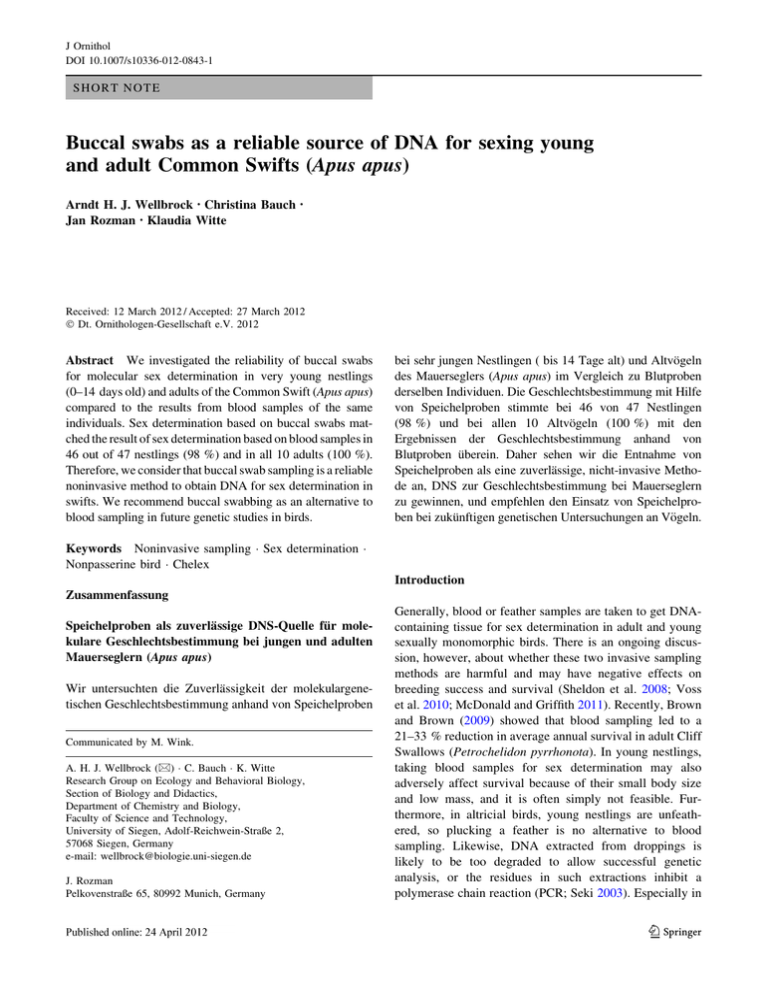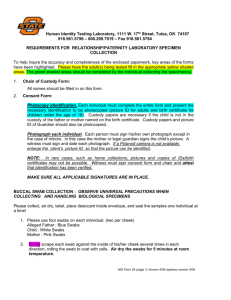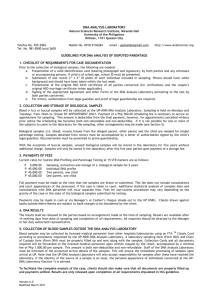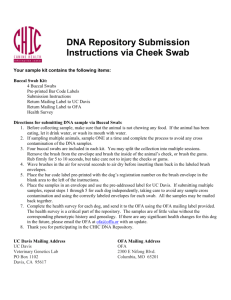Buccal swabs as a reliable source of DNA for sexing... and adult Common Swifts (Apus apus)
advertisement

J Ornithol DOI 10.1007/s10336-012-0843-1 SHORT NOTE Buccal swabs as a reliable source of DNA for sexing young and adult Common Swifts (Apus apus) Arndt H. J. Wellbrock • Christina Bauch Jan Rozman • Klaudia Witte • Received: 12 March 2012 / Accepted: 27 March 2012 Ó Dt. Ornithologen-Gesellschaft e.V. 2012 Abstract We investigated the reliability of buccal swabs for molecular sex determination in very young nestlings (0–14 days old) and adults of the Common Swift (Apus apus) compared to the results from blood samples of the same individuals. Sex determination based on buccal swabs matched the result of sex determination based on blood samples in 46 out of 47 nestlings (98 %) and in all 10 adults (100 %). Therefore, we consider that buccal swab sampling is a reliable noninvasive method to obtain DNA for sex determination in swifts. We recommend buccal swabbing as an alternative to blood sampling in future genetic studies in birds. bei sehr jungen Nestlingen ( bis 14 Tage alt) und Altvögeln des Mauerseglers (Apus apus) im Vergleich zu Blutproben derselben Individuen. Die Geschlechtsbestimmung mit Hilfe von Speichelproben stimmte bei 46 von 47 Nestlingen (98 %) und bei allen 10 Altvögeln (100 %) mit den Ergebnissen der Geschlechtsbestimmung anhand von Blutproben überein. Daher sehen wir die Entnahme von Speichelproben als eine zuverlässige, nicht-invasive Methode an, DNS zur Geschlechtsbestimmung bei Mauerseglern zu gewinnen, und empfehlen den Einsatz von Speichelproben bei zukünftigen genetischen Untersuchungen an Vögeln. Keywords Noninvasive sampling Sex determination Nonpasserine bird Chelex Introduction Zusammenfassung Speichelproben als zuverlässige DNS-Quelle für molekulare Geschlechtsbestimmung bei jungen und adulten Mauerseglern (Apus apus) Wir untersuchten die Zuverlässigkeit der molekulargenetischen Geschlechtsbestimmung anhand von Speichelproben Communicated by M. Wink. A. H. J. Wellbrock (&) C. Bauch K. Witte Research Group on Ecology and Behavioral Biology, Section of Biology and Didactics, Department of Chemistry and Biology, Faculty of Science and Technology, University of Siegen, Adolf-Reichwein-Straße 2, 57068 Siegen, Germany e-mail: wellbrock@biologie.uni-siegen.de J. Rozman Pelkovenstraße 65, 80992 Munich, Germany Generally, blood or feather samples are taken to get DNAcontaining tissue for sex determination in adult and young sexually monomorphic birds. There is an ongoing discussion, however, about whether these two invasive sampling methods are harmful and may have negative effects on breeding success and survival (Sheldon et al. 2008; Voss et al. 2010; McDonald and Griffith 2011). Recently, Brown and Brown (2009) showed that blood sampling led to a 21–33 % reduction in average annual survival in adult Cliff Swallows (Petrochelidon pyrrhonota). In young nestlings, taking blood samples for sex determination may also adversely affect survival because of their small body size and low mass, and it is often simply not feasible. Furthermore, in altricial birds, young nestlings are unfeathered, so plucking a feather is no alternative to blood sampling. Likewise, DNA extracted from droppings is likely to be too degraded to allow successful genetic analysis, or the residues in such extractions inhibit a polymerase chain reaction (PCR; Seki 2003). Especially in 123 J Ornithol experimental studies, it is necessary to determine the sex of a nestling as soon as possible after hatching. Thus, a feasible alternative noninvasive sampling method to get DNA material for sexing birds is to sample buccal swabs. Buccal swabs are commonly used in epidemiological and forensic investigations to acquire human DNA (Handel et al. 2006). They were applied recently in field and laboratory studies of nonhuman mammals (e.g., Brooks et al. 2003; Mitrečić et al. 2008), reptiles and amphibians (e.g., Poschadel and Möller 2004), and even fish (Smalley and Campanella 2005). Although buccal swabs have lately been used in bird studies (e.g., Brubaker et al. 2011; Yannic et al. 2011), only a few studies have evaluated the reliability of buccal swabs for sex determination in birds, especially in very young nestlings (Seki 2003; Arima and Ohnishi 2006; Handel et al. 2006). The aim of our study was to carry out such an evaluation by using buccal swabs of young nestlings (aged between 0 and 14 days) and adults of the Common Swift (Apus apus). We validated the accuracy of the method by comparing the results with those of sex determination based on blood samples from the same individuals. Methods Study site and sampling We sampled Common Swifts in a breeding colony situated in a concrete federal highway bridge spanning the Bigge Reservoir near Olpe, North Rhine-Westphalia, Germany (51°020 3300 N 07°490 4000 E). During breeding season in 2009 and 2010, we collected both buccal swabs and blood samples from 11 adult birds and 53 nestlings. Nestlings were individually marked immediately after hatching. At the time of buccal swab sampling, 26 nestlings were 0–4 days old (body mass: 2.29–10.42 g) and 27 nestlings were 8–14 days old (body mass: 26.24–40.86 g; ±0.01 g accuracy; KERN digital balance). Buccal swabs were taken according to a manual enclosed with a mini sample kit developed by I. Adam, M. Honarmand, and C. Scharff (pers. comm.; Adam’s manual). Accordingly, we used a strip of chromatography paper (strip size: about 10 cm in length 9 4 mm in width) to sample DNA-containing epithelial cells with saliva. Each insalivated tip of the paper strip was cut off and placed in 200 ll of 5 % (w/w) Chelex100TM (Bio-Rad Laboratories, München, Germany). We took blood samples from the same individuals by brachial venipuncture (stored in 1 ml PBS/EDTA buffer). Nestlings were sampled at the age of 18–21 days. Genetic analysis DNA of buccal swabs was extracted according to the protocol of Adam’s manual. Each sample was incubated at 123 56 °C for 15 min in a water bath and vortexed for 10 s afterwards. The samples were then boiled for 8 min in a water bath and vortexed for 10 s again. Finally, the samples were centrifuged at 13,0009g for 3 min. DNA of blood samples was extracted either with a NucleoSpinTM blood purification kit (Macherey-Nagel, Düren, Germany) or using a standard proteinase K/chloroform-isoamyl alcohol method. We amplified sequences of the chromodomain helicase DNA-binding (CHD) genes on the W and Z sex chromosomes using the P8/P2 primer set (Griffiths et al. 1998). PCR amplifications of DNA were performed in a final volume of 25 ll on a TProfessional thermocycler (Biometra, Göttingen, Germany). Each reaction volume contained 10 mM Tris-HCl (pH 8.0), 50 mM KCl, 2.0 mM MgCl2 [109 Taq buffer advanced and MgCl2 (25 mM); VWR International, Darmstadt, Germany], 200 lM of each dNTP (Carl Roth, Karlsruhe, Germany), and 1.5 units of 5 PRIME Taq polymerase (VWR). We used 5 pmol of each primer in reactions for buccal swabs and 4 pmol in reactions for blood samples, respectively. Finally, we added 11–13 ll of DNA solution from buccal swabs or 1–2 ll of DNA extract from blood samples to the respective reaction mixture. PCR with DNA from buccal swabs started at 94 °C for 5 min, continued for 46 cycles of 94 °C for 30 s, 47 °C for 30 s, and 72 °C for 45 s, and finished with 72 °C for 5 min (Adam’s manual). Reaction volumes with DNA from blood underwent a program starting with 95 °C for 2 min, continuing with 31 cycles of 94 °C for 30 s, 47 °C for 1 min, and 72 °C for 45 s, and ending with 72 °C for 7 min. PCR was performed only once per individual. In swifts, PCR with the primer set P8/P2 yields a product of 370 base pairs (bp) from the Z chromosome and a product of 380 bp from the W chromosome. Reverse primer P2 was FAM-labeled to separate out sex-specific signals using an automated ABI DNA sequencer (ABI 3130 or 3730). The fragment length was determined with the Peak ScannerTM software package, version 1.0 (Applied Biosystems, Life Technology Corp., CA, USA). We assigned sex based on the absence (male) or presence (female) of the 380 bp signal from the W chromosome (Fig. 1). Results In nestlings, PCR amplification and sex determination based on blood samples were successful in all samples (n = 53). We determined 26 males and 27 females. Using DNA from buccal swabs, a PCR product could be amplified in 47 out of 53 nestlings (89 %). In 46 out of these 47 samples (98 %), sex determination based on DNA from buccal swabs was identical to that based on DNA from blood samples. J Ornithol Relative fluorescence units 1200 a Male 1000 800 600 400 200 350 360 370 380 390 400 390 400 Fragment size [bp] Relative fluorescence units 1200 b Female 1000 800 600 400 200 350 360 370 380 Fragment size [bp] Fig. 1a–b Fluorescence signals (solid lines) of the FAM-labeled PCR products amplified with P8/P2 primer set using DNA from buccal swabs of the Common Swift (a adult male, b female nestling). The 380 bp signal from the W chromosome is only present in females. Dotted signals come from a size standard In adult swifts, a PCR product was obtained from all blood samples and the sex of each bird was determined (n = 11). In 10 out of 11 adults, buccal swabs could be used for sex determination (91 % PCR success rate). We got a 100 % match between sex determination using DNA from buccal swabs and DNA from blood samples in adult birds. Discussion Our study provides a good indication of the reliability of buccal swabs as an alternative source of DNA for sexing adults and very young nestlings in the Common Swift. The amount of DNA was sufficient to successfully perform a PCR, even in buccal swabs taken from nestlings immediately or within the first days after hatching. Although PCR amplification was carried out only once for each individual bird, we received a PCR product in a high percentage of buccal swabs (success rate: 89 % in nestlings, 91 % in adults). Arima and Ohnishi (2006) achieved an overall PCR success rate of 82.2 % (88 out of 107 individual samples) in sex determination via buccal swabs in 12 wild bird species (adults of 11 passerine species and nestlings of the Great Cormorant Phalacrocorax carbo). In other studies concerning bird sexing, PCR amplification failure either did not occur or was not mentioned (Seki 2003; Handel et al. 2006; Brubaker et al. 2011). Likewise, we achieved high consistency in results of sex determination based on DNA from buccal swabs and based on DNA from blood samples (98 % matching in nestlings, 100 % in adults). As far as we know, this is the first study evaluating the reliability of buccal swabs for sexing in a small nonpasserine bird. Moreover, we were able to show that taking buccal swabs is feasible for sensitive bird species like the Common Swift, for which it is important to minimize any manipulation and duration of handling the birds. Animal welfare considerations (e.g., the 3R principle as published by Russell and Burch 1959) and issues regarding the protection of endangered bird species also strongly indicate the implementation of sampling methods that do not impose unnecessary harm and distress on the animals. Therefore, we strongly recommend buccal swabbing as a noninvasive sampling method in birds, and especially in nestlings which are too small for blood sampling. Acknowledgments We would like to thank Sebastian Steinfartz and Elke Hippauf (support during laboratory work; University of Bielefeld), Iris Adam, Mariam Honarmand, and Constance Scharff (mini sample kit; Freie Universität Berlin), Josef Knoblauch and Matthias Klein (discoverer of the swift colony), Wolfgang Hoffmann (for permission to work in the bridge; Straßen NRW), and Rainer Grebe (electricity supply; Lister- und Lennekraftwerke GmbH). Blood samples and buccal swabs from Common Swifts were taken under a licence from the Landesamt für Natur, Umwelt und Verbraucherschutz NRW (Aktenzeichen: 9.93.2.10.41.07.095). The study was funded by the Ethologische Gesellschaft e.V. (Marburg/Lahn) and by research funding from the University of Siegen. References Arima H, Ohnishi N (2006) Usefulness of avian buccal cells for molecular sexing. Ornithol Sci 5:139–143 Brooks R, Williamson J, Hensley A, Butler E, Touchton G, Smith E (2003) Buccal cells as a source of DNA for comparative animal genomic analysis. Biotechnol Lett 25:451–454 Brown MB, Brown CR (2009) Blood sampling reduces annual survival in Cliff Swallows (Petrochelidon pyrrhonota). Auk 126:853–861 Brubaker JL, Karouna-Renier NK, Chen Y, Jenko K, Sprague DT, Henry PFP (2011) A noninvasive, direct real-time PCR method for sex determination in multiple avian species. Mol Ecol Resour 11:415–417 Griffiths R, Double MC, Orr K, Dawson RJG (1998) A DNA test to sex most birds. Mol Ecol 7:1071–1075 Handel CM, Pajot LM, Talbot SL, Sage GK (2006) Use of buccal swabs for sampling DNA from nestling and adult birds. Wildl Soc Bull 34:1094–1100 123 J Ornithol McDonald PG, Griffith SC (2011) To pluck or not to pluck: the hidden ethical and scientific costs of relying on feathers as a primary source of DNA. J Avian Biol 42:197–203 Mitrečić D, Mavrić S, Vrabec Branica B, Gajović S (2008) Mice genotyping using buccal swabs: an improved method. Biochem Genet 46:105–112 Poschadel JR, Möller D (2004) A versatile field method for tissue sampling on small reptiles and amphibians, applied to pond turtles, newts, frogs and toads. Conserv Genet 5:865–867 Russell WMS, Burch RL (1959) The principles of humane experimental technique. Methuen, London Seki S-I (2003) Molecular sexing of individual Ryukyu Robins Erithacus komadori using buccal cells as a non-invasive source of DNA. Ornithol Sci 2:135–137 123 Sheldon LD, Chin EH, Gill SH, Schmaltz G, Newman AEM, Soma KK (2008) Effects of blood collection on wild birds: an update. J Avian Biol 39:369–378 Smalley JV, Campanella JJ (2005) Buccal swabbing and extraction of high quality sunfish (Lepomis) DNA for use in PCR analysis. BioTechniques 38:188–192 Voss M, Shutler D, Werner J (2010) A hard look at blood sampling of birds. Auk 127:704–708 Yannic G, Sermier R, Aebischer A, Gavrilo MV, Gilg O, Miljeteig C, Sabard B, Strøm H, Pouivé E, Broquet T (2011) Description of microsatellite markers and genotyping performances using feathers and buccal swabs for the ivory gull (Pagophila eburnea). Mol Ecol Resour 11:877–889






